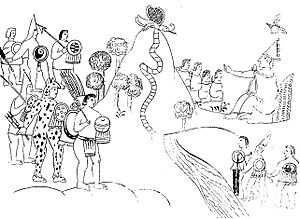Ramírez Codex facts for kids

The Ramírez Codex is an old book from the late 1500s. It was written after the Spanish arrived in Mexico. This special book is called Relación del origen de los indios que hábitan esta Nueva España según sus Historias. This means "An Account of the Origin of the Indians who Live in this New Spain according to their Histories."
The book is named after José Fernando Ramírez. He was a Mexican expert who found it in 1856. He found it in a old building called the convent of San Francisco in Mexico City. It's important not to mix it up with the Tovar Codex, which is a different book.
Contents
What is the Ramírez Codex?
This book was probably made by a Jesuit priest named Juan de Tovar. He worked on it around 1583-1587. He was helped by a historian named José de Acosta. The book tells the story of the Aztec people. It starts from their legendary home, Aztlan, and goes up to the Spanish conquest.
The Ramírez Codex has text and 32 drawings. These drawings are similar to ones in another book by Diego Durán. The Ramírez Codex is thought to be an early draft of the Tovar Codex. The Tovar Codex is a later, colorful version of the same story. It was sent to Spain and is now in a library in Providence.
Sections of the Codex
The Codex Ramírez has three main parts:
- A history of the Aztec empire.
- A section about Aztec gods and their festivals.
- A short part about the native calendar.
The first part, about Aztec history, is the most important. It tells how the Aztec empire grew. It also describes the Spanish conquest. Tovar said he got his information from Aztec people in Tula. But many historians think he also used parts of Diego Durán's work. This is because their books are very similar.
The "Chronicle X"
Many experts believe that Tovar and Durán used an even older source. This source was probably written in the Nahuatl language. It was likely put together by Aztec historians soon after the Spanish conquest. This lost document is often called "Crónica X" ("Chronicle X").
This "Chronicle X" is thought to be the original source for several early books. These include the Ramírez Codex, Durán's works, and Acosta's codices. They all have similar stories. They also all praise Tlacaelel, who was a very important Aztec leader. He helped the Aztec empire grow and become strong.
The Drawings in the Codex
The drawings in the Ramírez Codex were made by an Aztec artist. These artists were called tlacuiloque. The drawings are not colored. You can still see notes on some pages, like numbers 26 and 28. These notes were for adding color later.
The first 18 drawings are like those in Durán's book. Drawings 29 and 30 show calendar wheels. The last two drawings are unique. They show scenes from the Spanish Conquest.
How the Codex Was Found
José Fernando Ramírez found the Ramírez Codex in 1856. He found it in the library of the San Francisco convent in Mexico City. Ramírez planned to publish it. But he passed away before it was printed.
The book was finally published by Manuel Orozco y Berra in 1847. It was part of his edition of Crónica Mexicana. This was a work by Fernando Alvarado Tezozomoc. To honor Ramírez, Orozco y Berra named the codex after him. He published the Codex Ramírez and Tezozomoc's work together. He also included Ramírez's introduction. The drawings from the Codex Ramírez were placed throughout the whole book.
The Codex Ramírez was first published on its own in 1979. This was done by Editorial Inovación. Since then, the book has been translated into French and English.
The Illustrations of the Ramírez Codex
See also
 In Spanish: Códice Ramírez para niños
In Spanish: Códice Ramírez para niños
- Mesoamerican Codices
- Aztec codices
- Diego Durán














